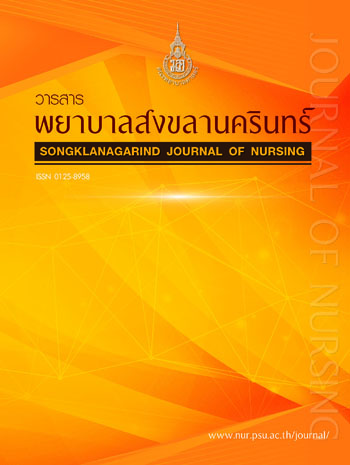Effect of Positioning on Gastric Residual Volume in Preterm Infants
Main Article Content
Abstract
This cross-over, quasi-experimental research was conducted to compare the mean percentage of
gastric residual volume in preterm infants who were randomly positioned with head elevated in supine, right
anterior oblique, prone and right lateral positions admitted in the Neonatal Intensive Care Unit (NICU),
Hatyai Hospital. Purposive sampling was performed to recruit 63 preterm infants. The data were collected
before and after feeding at 1, 2 and 3 hours using: 1) a demographic data record form, and 2) a feeding
volume and gastric residual volume record form. The validity of the questionnaire was verified by three
experts. The inter-rater reliability of the feeding volume and gastric residual volume record form between
the researcher and the research assistant was estimated, yielding an agreement of 100 percent. Data were
analyzed using descriptive statistics, one-way analysis of variance, and Scheffe’s test.
The results revealed that there were no significant differences of the mean percentage of gastric
residual volume before feeding in preterm infants who were positioned with head elevated in supine, right
anterior oblique, prone and right lateral positions (p> .05). After feeding at one hour, there were significant
differences of the mean percentage of gastric residual volume in each pair of preterm infants who were
positioned with head elevated positions (e.g., supine vs prone, supine vs right anterior oblique, and supine
vs right lateral position, p< .05). There were no significant differences of the mean percentage of gastric
residual volume of the infants who were positioned with head elevated in prone and right anterior oblique
(p> .05). After feeding at two hours, there were significant differences of the mean percentage of gastric
residual volume in each pair of preterm infants who were positioned in head elevated positions (e.g., supine
vs prone, supine vs right anterior oblique, and supine vs right lateral, p<.01; prone vs right lateral, p< .05).
There were no significant differences of the mean percentage of gastric residual volume of the infants who
were positioned with head elevated in right anterior oblique and right lateral, and prone and right anterior
oblique, (p> .05). After feeding at three hours, there were significant differences of the mean percentage of
gastric residual volume in each pair of preterm infants who were positioned with head elevated positions
(e.g., supine vs prone, supine vs right anterior oblique, and supine vs right lateral, p< .001). There were
no significant differences of the average percentage of gastric residual volume of the infants who were
positioned with head elevated in prone and right anterior oblique, prone and right lateral, and right anterior
oblique and right lateral (p> .05). Preterm infants had the lowest to the highest mean percentage of gastric
residual volumes when positioning them in right lateral, right anterior oblique, prone, and supine positions,
respectively, after feeding at 1, 2 and 3 hours. Thus, the first position in which nurses should place the preterm infants after feeding for 3 hours is the head elevated in right lateral position. The second and the
third positions are head elevated in right anterior oblique and prone positions.


